Articles & Videos
Fears Grow Over Unprecedented Canadian Rail Shutdown

It’s not the news that business leaders were hoping for but the failure of negotiations last night marks the start of an unprecedented Canadian rail shutdown. The two largest railways; Canadian National Railway Company and Canadian Pacific Kansas City (CPKC) have now downed tools, a motion that we’ve never seen prior and one that creates significant disruption not only to the Canadian economy but also to the U.S. and potentially even the global economy. The shutdown affects numerous industries that rely heavily on rail transportation for the movement of goods and threatens to create ripple effects across supply chains that are deeply interconnected across borders, making this an issue of international concern.
The Breadth and Scope of the Canadian Rail Strikes
The strikes have paralyzed a significant portion of Canada’s rail network, which is a critical artery for both domestic and international trade. Canadian railways are responsible for transporting a vast array of goods, from raw materials like lumber, minerals and oil to finished products destined for domestic markets and export. With the rail lines now inactive, the movement of these goods has come to a standstill, severely impacting industries and consumers that rely on timely deliveries.
Impact on Industries and Economies
Manufacturing and Automotive Industries
One of the most immediate impacts will be felt by the manufacturing and automotive sectors in both Canada and the United States. These industries operate on just-in-time production systems, meaning they rely on the regular and precise delivery of parts and materials to keep their assembly lines running. A prolonged disruption in rail services could lead to production halts, layoffs and significant financial losses. Automakers, in particular, may struggle to receive the necessary components, which could delay vehicle production and affect sales.
Agriculture and Food Supply
The agricultural sector is also at significant risk. Canada is a major exporter of grains, oilseeds, fertilizers and other agricultural products, much of which is transported by rail to ports for international shipping. With the rail network down, these exports will be delayed, potentially leading to spoilage, lessened yields and loss of revenue for farmers. Moreover, the disruption could cause shortages in the domestic food supply, driving up prices and causing further economic strain on consumers.
Energy Sector
Canada’s energy sector, particularly the oil and gas industry, could face severe repercussions. A significant portion of Canadian crude oil is transported via rail to refineries in the United States. The strikes could choke off this supply, leading to shortages and potentially higher fuel prices in the US. This disruption also has the potential to impact the global oil market, as the US is a key player in global energy consumption and trade.
Retail and Consumer Goods
The retail sector in both Canada and the US is likely to experience delays in the delivery of consumer goods, especially ahead of key shopping periods. Retailers depend on rail networks to replenish their inventories and any disruption could result in empty shelves and lost sales. This is particularly concerning as businesses build inventory and prepare for the upcoming holiday season, a critical period for retail sales.
Broader Economic Impacts
The strikes are expected to have a cascading effect on the broader economy. As industries grapple with supply chain disruptions, there could be a slowdown in economic activity, leading to lower GDP growth in both Canada and the United States. The interconnectedness of the global supply chain means that the impact could spread beyond North America, affecting businesses and economies worldwide.
The challenge for businesses will be two-pronged as outside of the lack of goods being moved, commuters now need to find alternative ways to get into their workplaces. In Toronto, Vancouver and Montreal, thousands of workers would have been scrambling for alternative modes of transport today given that commuter rail networks rely on CPKC dispatchers to route their trains over the freight railroad’s tracks.
Mitigation Strategies for Businesses
In the face of such unprecedented disruption, businesses on both sides of the border must explore strategies to mitigate the impact of the strikes.
Diversification of Supply Chains
One of the primary strategies is the diversification of supply chains. Businesses should consider alternative transportation methods, such as trucking or shipping, to move their goods. While these alternatives may be more costly and less efficient, they can serve as temporary measures to keep goods flowing.
Increased Inventory Levels
Companies may also choose to increase their inventory levels as a buffer against future disruptions. By holding more stock, businesses can continue operations for a longer period even if supplies are delayed. However, this strategy comes with the challenge of higher storage costs and the risk of inventory obsolescence.
Collaborative Efforts and Government Intervention
Collaboration between businesses, industry and commerce associations, and governments is crucial in managing the crisis. Governments in both Canada and the US may need to intervene to facilitate negotiations between labor unions and rail companies to reach a resolution quickly. Additionally, temporary regulatory measures, such as relaxing trucking regulations, could help alleviate some of the strain on the transportation network.
Adoption of Technology
Businesses can also leverage technology to improve supply chain visibility and flexibility. Advanced analytics and supply chain management software can help companies better anticipate disruptions and plan accordingly. This approach allows businesses to make informed decisions about inventory management, transportation, and production schedules. Whilst this is a key supply chain management tool, it won’t help with this current disruption already underway.
Future of Canadian Rail Systems Must be Preserved
The Canadian Rail networks are vital to the economy, with no feasible alternative to moving goods across vast expanses of a huge country. The strikes represent a significant challenge not only to the Canadian economy but also to the broader North American and global economies. The widespread impact across various industries underscores the importance of rail transportation in the modern economy. As businesses and governments work to mitigate the effects of the strikes, it becomes clear that the interconnected nature of global supply chains requires robust strategies and collaboration to manage such disruptions. The outcome of these strikes will likely influence future labor negotiations and transportation policies, highlighting the need for resilience and adaptability in an increasingly complex global economy.
The last time there was a Canadian rail strike was 2012 and the government eventually intervened to get workers back on track, whether that happens this time remains to be seen. Whatever the remedy to this current stoppage, it’s clear that it needs to be a speedy resolution to limit the impact on consumers, businesses and already static 2024 economic growth.
Search
News
$1M Funding Fuels Agri-Business Growth Across Borders
Sallyport is pleased to announce a new partnership with a Canadian agriculture business, providing a $1,000,000 Accounts Receivable facility to…
Read MoreFueling EdTech Growth with $5.5M in Tailored Financing
Sallyport is excited to support a forward-thinking education technology company with a $5.5M combined Asset-Based Lending facility, including Accounts Receivable…
Read MoreArticles
What are the Biggest Risks to Business in 2021 and Beyond
If this was asked at this point last year, the response would be in major contrast as to the biggest…
Read MoreHow to Extend Credit to Customers the Right Way
In the current climate it’s highly likely you’ve already been asked to extend credit terms to your customers. Small businesses…
Read MoreVideos
AG Machining Client Testimonial
AG Machining Client Testimonial
View NowAmerican Business Women’s Day
Sallyport Commercial Finance Celebrates American Business Women’s Day
View Now



